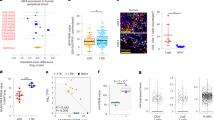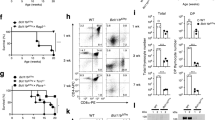Abstract
SEVERAL bacterial pathogens of medical importance are able to persist and replicate inside host mononuclear phagocytes. Protective immunity depends on specific T lymphocytes that induce granulomatous lesions at the sites of bacterial multiplication1,2. Listeria monocytogenes is an intracellular pathogen that replicates inside mononuclear phagocytes and hepatocytes of mice1–4. Invasion from the phagosomal compartment into the cytoplasmic compartment is the principal mechanism of intracellular survival5. Early in infec-tion, resistance against L. monocytogenes is mediated by polymor-phonuclear phagocytes which destroy infected liver cells, followed by natural killer cells which activate macrophages by means of interferon-γ (refs 6, 7). A specific immune response by T cells then develops which leads to sterile eradication of the microbes1,2,8. T cells are also responsible for the highly effective protection in vaccinated mice against secondary infections1,2. Although the role of αβ T cells has been demonstrated in these immune responses, that of γδ T cells is unclear2,9,10. Here we use mice that selectively lack either αβ or γδ T cells as a result of targeted germ-line mutations in their T-cell receptor genes11,12 to investigate the relative roles of these T-cell populations during experimental infection with L. monocytogenes. We find that in primary listeriosis, either αβ or γδ T cells are sufficient for early protection. Resistance to second-ary infection is mediated mainly by αβ T cells but also involves γδd T cells. Thus αβ T-cell-deficient mice can be rendered partially resistant by vaccination, and γδ T cells are shown to be responsible for this protective effect. In infected γδ T-cell-deficient mice we noticed the appearance of unusual liver lesions, indicating that γδ T cells have a unique regulatory role in this bacterial infection.
This is a preview of subscription content, access via your institution
Access options
Subscribe to this journal
Receive 51 print issues and online access
$199.00 per year
only $3.90 per issue
Buy this article
- Purchase on Springer Link
- Instant access to full article PDF
Prices may be subject to local taxes which are calculated during checkout
Similar content being viewed by others
References
Hahn, H. & Kaufmann, S. H. E. Rev. Infect. Dis. 3, 1221–1250 (1981).
Kaufmann, S. H. E. A. Rev. Immun. 11, 129–163 (1993).
Gregory, S. H., Wing, E. J., Hoffman, R. A. & Simmons, R. L. J. Immun. 150, 2901–2909 (1993).
North, R. J. J. exp. Med. 132, 521–524 (1970).
Portnoy, D. A., Jacks, P. S. & Hinrichs, D. J. J. exp. Med. 167, 1459–1471 (1988).
Conlan, J. W. & North, R. J. J. exp. Med. 174, 741–744 (1991).
Bancroft, G. J., Schreiber, R. D. & Unanue, E. R. Immun. Rev. 124, 5–24 (1991).
Kaufmann, S. H. E. & Hahn, H. J. exp. Med. 155, 1754–1765 (1982).
Hiromatsu, K. et al. J. exp. Med. 175, 49–56 (1992).
Haas, W., Pereira, P. & Tonegawa, S. A. Rev. Immun. 11, 637–686 (1993).
Mombaerts, P. et al. Nature 360, 225–231 (1992).
Itohara, S. et al. Cell 72, 337–348 (1993).
Goodman, T. & Lefrancois, L. J. exp. Med. 170, 1569–1581 (1989).
Mombaerts, P. et al. Cell 68, 869–877 (1992).
Kaufmann, S. H. E., Hug, E., Väth, U. & Müller, I. Infect. Immun. 48, 263–266 (1985).
Dunn, P. L. & North, R. J. J. infect. Dis. 164, 869–877 (1991).
Roberts, A. D., Ordway, D. J. & Orme, I. M. Infect. Immun. 61, 1113–1116 (1993).
Emmerling, P., Finger, H. & Bockemühl, J. Infect. Immun. 12, 437–439 (1974).
Baldridge, J. R., Barry, R. A. & Hinrichs, D. J. Infect. Immun. 58, 654–658 (1990).
Buchmeier, N. A. & Schreiber, R. D. Proc. natn. Acad. Sci. U.S.A. 82, 7404–7408 (1985).
Kiderlen, A. F., Kaufmann, S. H. E. & Lohmann-Matthes, M.-L. Eur. J. Immun. 14, 964–967 (1984).
Harty, J. T., Schreiber, R. D. & Bevan, M. J. Proc. natn. Acad. Sci. U.S.A. 89, 11612–11616 (1992).
Kaufmann, S. H. E. Microbial Pathogen. 1, 249–260 (1986).
Singh, I. G., Mukherjee, R., Talwar, G. P. & Kaufmann, S. H. E. Infect. Immun. 60, 257–263 (1992).
Author information
Authors and Affiliations
Rights and permissions
About this article
Cite this article
Mombaerts, P., Arnoldi, J., Russ, F. et al. Different roles of αβ and γδ T cells in immunity against an intracellular bacterial pathogen. Nature 365, 53–56 (1993). https://doi.org/10.1038/365053a0
Received:
Accepted:
Issue Date:
DOI: https://doi.org/10.1038/365053a0
This article is cited by
-
Spectratype analysis of the T cell receptor δ CDR3 region of bovine γδ T cells responding to leptospira
Immunogenetics (2015)
-
γδ T Cells Augment Rejection of Skin Grafts by Enhancing Cross-Priming of CD8 T Cells to Skin-Derived Antigen
Journal of Investigative Dermatology (2012)
-
The light and dark sides of intestinal intraepithelial lymphocytes
Nature Reviews Immunology (2011)
-
Regulation and function of IL-17A- and IL-22-producing γδ T cells
Cellular and Molecular Life Sciences (2011)
-
Current progress in γδ T-cell biology
Cellular & Molecular Immunology (2010)
Comments
By submitting a comment you agree to abide by our Terms and Community Guidelines. If you find something abusive or that does not comply with our terms or guidelines please flag it as inappropriate.



